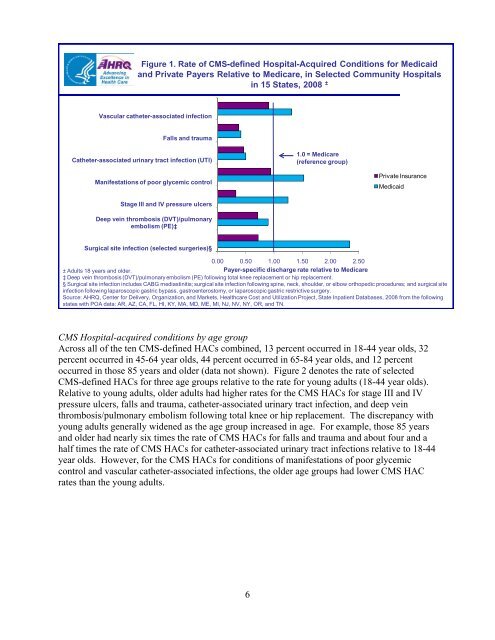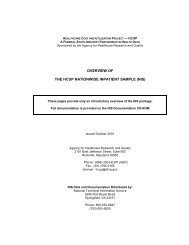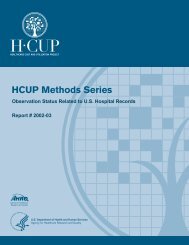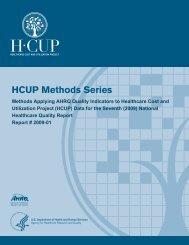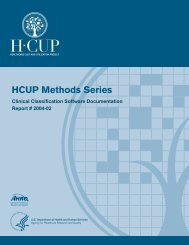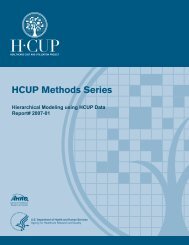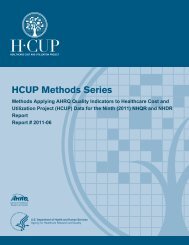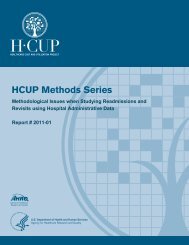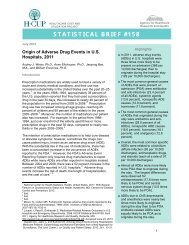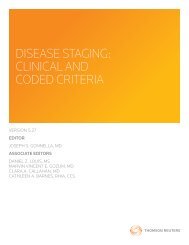An Example of Using Present on Admission Data - HCUP
An Example of Using Present on Admission Data - HCUP
An Example of Using Present on Admission Data - HCUP
Create successful ePaper yourself
Turn your PDF publications into a flip-book with our unique Google optimized e-Paper software.
Figure 1. Rate <str<strong>on</strong>g>of</str<strong>on</strong>g> CMS-defined Hospital-Acquired C<strong>on</strong>diti<strong>on</strong>s for Medicaidand Private Payers Relative to Medicare, in Selected Community Hospitalsin 15 States, 2008 ±Vascular catheter-associated infecti<strong>on</strong>Falls and traumaCatheter-associated urinary tract infecti<strong>on</strong> (UTI)1.0 = Medicare(reference group)Manifestati<strong>on</strong>s <str<strong>on</strong>g>of</str<strong>on</strong>g> poor glycemic c<strong>on</strong>trolPrivate InsuranceMedicaidStage III and IV pressure ulcersDeep vein thrombosis (DVT)/pulm<strong>on</strong>aryembolism (PE)‡Surgical site infecti<strong>on</strong> (selected surgeries)§0.00 0.50 1.00 1.50 2.00 2.50± Adults 18 years and older.Payer-specific discharge rate relative to Medicare‡ Deep vein thrombosis (DVT)/pulm<strong>on</strong>ary embolism (PE) following total knee replacement or hip replacement.§ Surgical site infecti<strong>on</strong> includes CABG mediastinitis; surgical site infecti<strong>on</strong> following spine, neck, shoulder, or elbow orthopedic procedures; and surgical siteinfecti<strong>on</strong> following laparoscopic gastric bypass, gastroenterostomy, or laparoscopic gastric restrictive surgery.Source: AHRQ, Center for Delivery, Organizati<strong>on</strong>, and Markets, Healthcare Cost and Utilizati<strong>on</strong> Project, State Inpatient <strong>Data</strong>bases, 2008 from the followingstates with POA data: AR, AZ, CA, FL, HI, KY, MA, MD, ME, MI, NJ, NV, NY, OR, and TN.CMS Hospital-acquired c<strong>on</strong>diti<strong>on</strong>s by age groupAcross all <str<strong>on</strong>g>of</str<strong>on</strong>g> the ten CMS-defined HACs combined, 13 percent occurred in 18-44 year olds, 32percent occurred in 45-64 year olds, 44 percent occurred in 65-84 year olds, and 12 percentoccurred in those 85 years and older (data not shown). Figure 2 denotes the rate <str<strong>on</strong>g>of</str<strong>on</strong>g> selectedCMS-defined HACs for three age groups relative to the rate for young adults (18-44 year olds).Relative to young adults, older adults had higher rates for the CMS HACs for stage III and IVpressure ulcers, falls and trauma, catheter-associated urinary tract infecti<strong>on</strong>, and deep veinthrombosis/pulm<strong>on</strong>ary embolism following total knee or hip replacement. The discrepancy withyoung adults generally widened as the age group increased in age. For example, those 85 yearsand older had nearly six times the rate <str<strong>on</strong>g>of</str<strong>on</strong>g> CMS HACs for falls and trauma and about four and ahalf times the rate <str<strong>on</strong>g>of</str<strong>on</strong>g> CMS HACs for catheter-associated urinary tract infecti<strong>on</strong>s relative to 18-44year olds. However, for the CMS HACs for c<strong>on</strong>diti<strong>on</strong>s <str<strong>on</strong>g>of</str<strong>on</strong>g> manifestati<strong>on</strong>s <str<strong>on</strong>g>of</str<strong>on</strong>g> poor glycemicc<strong>on</strong>trol and vascular catheter-associated infecti<strong>on</strong>s, the older age groups had lower CMS HACrates than the young adults.6


